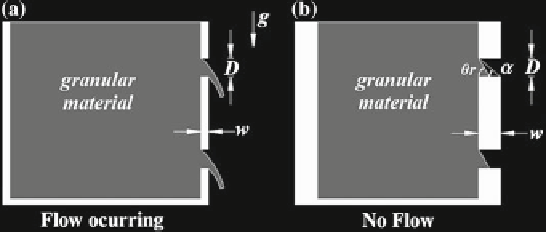Environmental Engineering Reference
In-Depth Information
where
D
d
. In this case, we performed experiments with sand and granulated
sugar and we found that the mass flow rate
m
obeys the relation
m
=
g
1
/
2
D
5
/
2
g
1
/
2
D
5
/
2
c
ˁ
[
arctan
(
D
/
w
)
−
ʸ
r
]=
c
ˁ
[
ʱ
−
ʸ
r
]
,
(2)
where now
c
is an effective dimensionless discharge coefficient for side wall flow,
ʸ
r
is the angle of repose of the granular material and
has been
termed the
angle of wall
(Medina et al.
2013
,
2014
). Equation (
2
) implies that the
wall thickness of the bin has an important influence on this gravity flow. Moreover,
the frictional nature of the granular material is introduced through the angle of repose
itself: in lateral outflows the flow will occurs if the orifice allows the existence of an
angle of wall larger than the angle of repose (see Fig.
8
).
By virtue of these facts it is clear that the wall thickness can be used to control
the discharge rate and the granular flow can be eventually arrested if
w
exceeds a
critical value which depends also on the angle of repose of the granular material.
From Eq. (
2
) it is straightforward to estimate the critical value,
w
c
, for which the
outflow will be arrested, i.e., there is no flow at all when
m
=
ʱ
=
arctan
(
D
/
w
)
0orif
ʱ
=
ʸ
r
. Thus,
the critical value of
w
for the arrest, is
w
c
=
D
/
tan
ʸ
r
.
(3)
Experiments made with sand and granulated sugar (granular solids) confirm this
result (Medina et al.
2013
,
2014
).
3.1 Mass Flow Rate for Large Grains Through Side Walls
Here we report experiments for non-cohesive granular materials made of grains with
large diameters. Specifically, in the experiments we used mustard grains and tapioca
pearls. Mustard has the following properties: mean diameter
d
=
1
.
85mm, bulk
cm
3
and angle of repose
22
ⓦ
. Tapioca pearls have mean
density
ˁ
=
0
.
72 gr
/
ʸ
r
=
Fig. 8
Schematic view of the bin and holes in the side wall when granular material crosses it.
In
a
the wall thickness,
w
, is small, consequently,
ʱ>ʸ
r
and the granular material will pass the
orifice. In
b
the wall thickness produces the condition
ʱ<ʸ
r
, whence there is no flow


Search WWH ::

Custom Search